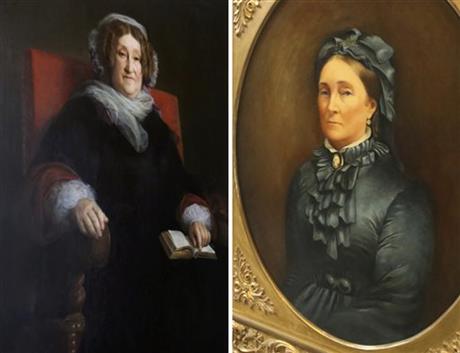REIMS, France (AP) — For Champagne to become the tipple it is today — popped at weddings, quaffed in casinos, sprayed by racing drivers and smashed against ships — a few men had to die.

Not just any old men. Young ones married to clever young women.
Without the widows of Champagne, mankind’s most seductive fizz might well not be what it is now. One of the world’s most famous Champagnes — Veuve (“Widow”) Clicquot — explicitly evokes the rather grim tradition. But other legendary houses — Bollinger, Laurent-Perrier and Pommery — also got their starts from tragedy-tinged widows. Then there are the many lesser-known names that still carry the widow tag, such as Veuve Fourny and Veuve Doussot.
From its bottle shape to its taste, color, labeling and even marketing, Champagne owes its uniqueness to a series of widows from the early 19th century who used the sometimes mysterious deaths of their husbands to enter the male-dominated business world. The widows became so successful that dozens of Champagnes added Veuve to their names even though no widow ran the house — just for its mystique and marketing value.
Champagne is the story of widows, said Francois Godard, scion of Veuve Godard et Fils Champagne house. Women who lost their husbands, and then outshone the men.
Widowhood gave these figures an independent social status in France. Unlike other women — who were the property of a father or a husband — only a widow could become a CEO.
In the 19th century … if you’re not married you’re dependent on your father, you can’t have a bank account and you can’t pay staff. If you are married you are reliant on your husbands, explained Fabienne Moreau, Veuve Clicquot’s archivist. Only a widow can take this position as head of a company.
Experts say that Champagne was one of the first industries in the modern world that women shaped and in which they enjoyed a prominent role.
The stern expressions of these women stare out from portraits that hang in their sprawling Reims-based mansions in the French region of Champagne, the only place in the world where bubbly can legally be called Champagne.
The story of the Champagne widows begins with Barbe-Nicole Clicquot.
Once upon a cold October’s day in 1805, Francois Clicquot, the young heir to a Champagne dynasty, suddenly died after a grape harvest, a few years after marrying the fresh-faced Barbe-Nicole.
It was a thunderbolt in the conservative Champagne landscape when the 27-year-old widow defied male opposition to take over the house.
Opportunistic and tough as nails, the young widow transformed the small house into a global empire. Madame Clicquot exploited the chaos created by Napoleonic wars to tap the European market, before taking in tipple-loving Russia and then the United States.
Champagne owes a lot to her. Madame Clicquot was the first businesswoman in France, and maybe the whole of Europe, says Moreau, who says that the house created the annual Business Woman Award in 1972 to evoke her legacy and champion the success of female entrepreneurs around the world.
Working until she dropped dead at 89, Veuve Clicquot left behind a formidable legacy: She invented rose Champagne, the world’s first Champagne label and — according to Moreau — was behind the distinctive modern Champagne bottle: slender and elegant in contrast to its clunky, heavy-set predecessor.
With the glass bottle, Veuve Clicquot smashed the glass ceiling.
Added to this was the invention of Veuve Clicquot’s revolutionary technique of rilling. It was a method of turning the bottle to get rid of nasty, cloudy sediment that stagnated in the drink, a process that made the beverage clear and pleasant. It’s still used today.
Widow Pommery was next.
Her husband died in unexplained circumstances in 1860.
We don’t know if Monsieur Pommery drank too much Champagne, or perhaps not enough, but he dies and leaves his business to the young widow, said Christine Prudhomme, head of visits at Pommery.
When he died, it was perhaps the opportunity she was looking for, said Prudhomme. She didn’t just want to be a wife. Her (widowhood) really gave her wings.
Prudhomme said that the house for decades was called Veuve Pommery, before the Veuve was removed. Subsequently, the widow was celebrated with the house’s best Champagne — Cuvee Louise — named after her.
The proliferation of Champagne widows may seem mysterious or suspicious, but experts explain the phenomenon through its era: The 19th century was a time before the invention of antibiotics, when men working in biting conditions outside would more easily succumb to deadly illness. The Champagne region was also an occasional stomping ground for foreign armies.
Both Veuve Clicquot and Veuve Pommery possessed such great audacity and ambition partly through the influence of an illustrious contemporary, Queen Victoria. The powerful English queen, also a widow, had a weakness for Champagne’s delicate effervescence and was counted among these two houses’ top clients.
Shrewd widow Pommery invented the world’s first brut Champagne — the dry Champagne we know today — in response to requests from Queen Victoria for variations of what had been a cloying drink. Brut Champagne revolutionized the industry again.
Before it was very sugary, sometimes 250-300 grams per liter, it was like jam or marmalade, said Thierry Gasco, cellar head at Vranken-Pommery.
By the time Veuve Pommery came along, widows had become a commercial asset. Men who ran Champagne houses would scramble to find a widow in the family after whom they could name their house, in hopes of boosting sales. That was the case with Veuve Godard et Fils.
There are the real widows and then there are the marketing widows, says Prudhomme. “Houses call themselves after widows because people will assume that there is a wonderful story behind the Champagne.
In a modern day testament to the widows’ legacy, Veuve Clicquot’s owner LVMH stands as the world’s largest Champagne maker, followed by Vranken-Pommery. Today there are 349 Champagne houses that together generate 4.4 billion euros ($5.9 billion) in revenue a year.
Widow Lilly Bollinger sealed the industry’s feminist reputation in 1941, when she took the reins from her deceased husband and rapidly expanded Bollinger internationally over three decades to the prominence it enjoys.
Bollinger was known for her bubbly wit.
I drink it when I’m happy and when I’m sad. Sometimes I drink it when I’m alone. When I have company I consider it obligatory. I trifle with it if I’m not hungry and drink it when I am. Otherwise, I never touch it, she once said, unless I’m thirsty.
___
Thomas Adamson can be followed athttps://twitter.com/ThomasAdamsonAP





